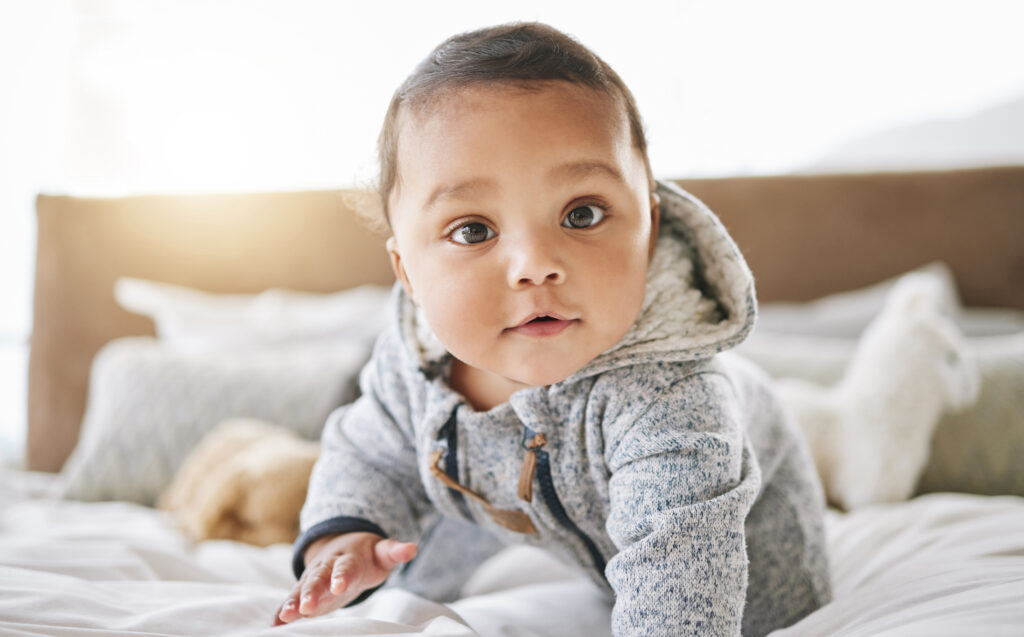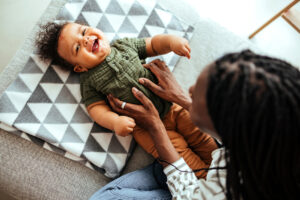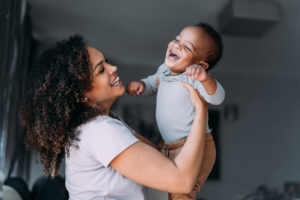By the time your baby reaches 6 months old, so much has changed – and fast! From stronger muscles to growing curiosity, your little one is hitting new 6 month developmental milestones that shape their future learning, social skills, and movement.
It’s exciting to watch, but it’s also normal to wonder: “Is my baby developing on track?” In this post, we’ll break down what most babies are doing around this age, when to talk to a doctor, and how you can support their development day to day.
Start with key milestones your baby reaches at 4 months.
What Are 6 Month Developmental Milestones?
6 month developmental milestones are the skills most babies typically reach around their half-year birthday. These include physical abilities, communication, emotional reactions, and cognitive skills.
According to the Centers for Disease Control and Prevention, by 6 months, most babies:
- Roll over in both directions
- Respond to their name
- Show interest in looking at themselves in the mirror
- Start to sit up with little or no support
- Babble with vowel sounds like “ah,” “oh,” and “eh”
- Reach for and grasp toys
These developmental milestones at 6 months are general expectations, not deadlines. Some babies may do these things earlier or later. What’s important is the overall pattern of progress.
Physical Development: Getting Stronger Every Day
Your baby is probably starting to sit upright with more stability. Many can roll from front to back and back to front and push up with their arms during tummy time.
According to the American Academy of Pediatrics, around 90% of babies can sit with support by 6 months, and about 50% can sit without support for brief moments.
Fine motor skills are also improving. Your baby may pass a toy from one hand to the other and start to rake small objects with their fingers.
Social and Emotional Growth
At this age, babies begin to show preferences for people and toys. They may:
- Smile at familiar faces
- Laugh out loud
- React to others’ emotions- sometimes crying if another baby cries
- Enjoy social play like peek-a-boo
This is an important time for bonding and building trust through face-to-face interaction.
Communication and Language Milestones
Speech development is more than just words – it begins with babbling. Your 6-month-old may start to:
- Babble strings of sounds like “ba-ba” or “da-da” (though not always linked to parents yet)
- Respond to their name
- Make sounds to express pleasure or discomfort
Studies show babies who are talked to more often at this age have stronger language skills by age 2.
Cognitive Skills: Curiosity in Action
Babies at this age are learning cause and effect, like what happens when they drop a toy. You may notice:
- Turning toward sounds
- Looking at nearby objects with interest
- Exploring objects with hands and mouth
They’re also learning object permanence – the understanding that things still exist even when out of sight, which is why they may look for a toy that rolled away.
Signs of Possible Delays
While every baby grows at their own pace, talk to your pediatrician if your baby:
- Doesn’t roll in either direction
- Seems stiff or floppy
- Doesn’t show affection for caregivers
- Isn’t babbling or making vowel sounds
These could be early signs of a delay and are worth checking out. Early intervention can help tremendously.
How to Support Your Baby’s Growth
You don’t necessarily need fancy toys – your voice, your face, and everyday moments are enough to help your baby thrive.
Try these:
- Talk and sing to your baby regularly
- Offer safe objects to reach, grasp, and explore
- Spend time doing tummy time
- Play games like peek-a-boo or mirror play
- Read picture books every day
Understanding 6-month developmental milestones gives you a helpful framework to track your baby’s growth. Keep in mind: babies develop at their own pace. Focus on progress, not perfection. And always trust your instincts – if you have concerns, reach out to your pediatrician for support.
Wondering what comes after your baby’s 6-month progress? Explore the essential 9-month developmental milestones to know what’s typical and when to seek support.



